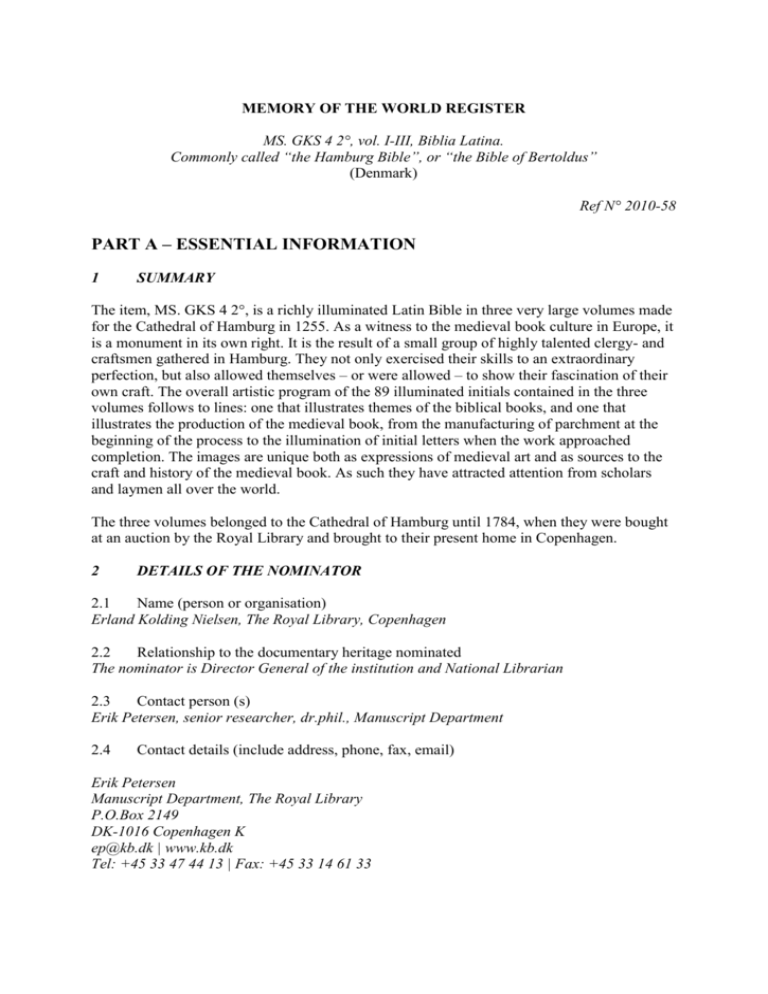Erik Petersen, senior researcher, dr.phil., Manuscript
advertisement

MEMORY OF THE WORLD REGISTER MS. GKS 4 2°, vol. I-III, Biblia Latina. Commonly called “the Hamburg Bible”, or “the Bible of Bertoldus” (Denmark) Ref N° 2010-58 PART A – ESSENTIAL INFORMATION 1 SUMMARY The item, MS. GKS 4 2°, is a richly illuminated Latin Bible in three very large volumes made for the Cathedral of Hamburg in 1255. As a witness to the medieval book culture in Europe, it is a monument in its own right. It is the result of a small group of highly talented clergy- and craftsmen gathered in Hamburg. They not only exercised their skills to an extraordinary perfection, but also allowed themselves – or were allowed – to show their fascination of their own craft. The overall artistic program of the 89 illuminated initials contained in the three volumes follows to lines: one that illustrates themes of the biblical books, and one that illustrates the production of the medieval book, from the manufacturing of parchment at the beginning of the process to the illumination of initial letters when the work approached completion. The images are unique both as expressions of medieval art and as sources to the craft and history of the medieval book. As such they have attracted attention from scholars and laymen all over the world. The three volumes belonged to the Cathedral of Hamburg until 1784, when they were bought at an auction by the Royal Library and brought to their present home in Copenhagen. 2 DETAILS OF THE NOMINATOR 2.1 Name (person or organisation) Erland Kolding Nielsen, The Royal Library, Copenhagen 2.2 Relationship to the documentary heritage nominated The nominator is Director General of the institution and National Librarian 2.3 Contact person (s) Erik Petersen, senior researcher, dr.phil., Manuscript Department 2.4 Contact details (include address, phone, fax, email) Erik Petersen Manuscript Department, The Royal Library P.O.Box 2149 DK-1016 Copenhagen K ep@kb.dk | www.kb.dk Tel: +45 33 47 44 13 | Fax: +45 33 14 61 33 3 IDENTITY AND DESCRIPTION OF THE DOCUMENTARY HERITAGE 3.1 Name and identification details of the items being nominated MS. GKS 4 2°, vol. I-III, Biblia Latina. Commonly called “the Hamburg Bible”, or “the Bible of Bertoldus”. 3.2 Description The Hamburg Bible is a Latin Bible copied on parchment in three large volumes. It was made for the Cathedral of Hamburg in 1255. Volume I consists of 242 leaves measuring 52 × 35.5 cm. Volume II has 230 leaves and measures 55.7 × 39 cm. Volume III consists of 218 leaves and measures 45 × 31 cm. The three volumes are all bound in late medieval bindings. The calculated length of the entire written text equals a line of more than 11,5 km. The total weight of the three volumes is close to 40 kg. The Hamburg Bible is not only a monument of medieval bookmaking, but also a unique expression of the medieval fascination with books. In addition to initials decorated with scenes from the books of the Bible, The Hamburg Bible also contains a sequence that demonstrates how medieval books were produced, from the production and preparation of parchment, to the various steps involved in the writing process and the painter’s work with illumination. While the motif of the monk busy writing is popular in medieval books, depictions of the other phases of the process of manuscript production are quite rare. The scenes depicting the production of the book are spread throughout all three volumes, but most of them are contained in volume three. Most are depictions either of St. Jerome, who translated the Bible into Latin, or of the Apostle Paul. The Hamburg Bible was produced in Hamburg in 1255 by an otherwise unknown scribe named Karolus at the request of Bertoldus, who served as Dean of the Chapter of Hamburg. Both men are named in the verse dedication that appears in all three volumes. The artist responsible for the Bible’s eighty-nine illuminated initials, however, is not named. The Hamburg Bible was acquired by the Danish Royal Library in 1784 at an auction of books belonging to the Chapter of Hamburg. Volume 1 contains the books of the Bible from Genesis to 2 Chronicles. The book begins with a full-page decorative initial that depicts the Creation in medallions in the downstroke of the I. The Fall of Man serves as the fulcrum, and is followed by the Banishment from Paradise, the Flood and Noah’s Ark. An arrow to the right indicates the continuation of the narrative. Volume 2 contains the Old Testament books from Ezra to Malachi. Volume 3 extends from the Books of the Maccabees in the Old Testament to the end of the New Testament. The last illumination of the volume – and of the entire The Hamburg Bible itself – is linked to the initial letter A in the Apocalypse or Book of Revelation. The anonymous illustrator has left his signature in the book by painting an illustrator at his desk in a frame beneath the text formed by an extension of the left downstroke of the letter A. We shall briefly summarize the content of the pictures related specifically to the production of the medieval book: Vol. I f. 137vb (Prologus Hieronymi in libros regum) In a U: St Jerome making the general layout and guidelines on a sheet of parchment. Vol. II f. 38va (Prephatio in librum Iob) In a C: St Jerome proof-reading a written sheet on his desk Vol. II f. 183ra (Prologus in Danielem) In a D: St Jerome and a parchment-maker Vol. II f. 195ra (Prephatio in duodecim prophetas) In an N: St Jerome cutting a piece of parchment into a sheet Vol. III f. 44ra (Matthaeus) In an L: St Matthew writing Vol. III f. 65rb (Marcus) In an I: St Mark writing [Vol. III f. 80ra (Lucas) In a Q: St Luke writing; excised folio] Vol. III f. 103vb (prologus in Johannem) In an H: St Jerome at his desk, writing; at his side: books Vol. III f. 104rb (Johannes) In an I: St John writing Vol. III f. 125ra (Ad Romanos) In a P: St Paul at the desk with ruled quire, writing Vol. III f. 133vb (Ad Corinthios I) In a P: St Paul writing, with pen and knife, and horns for ink in the desk Vol. III f. 142vb (Ad Corinthios II) In a P: St Paul and Timothy, St. Paul writing, Timothy preparing a sheet of parchment Vol. III f. 148va (Ad Galatas) In a P: St Paul writing Vol. III f. 158va (1 ad Thessalonicenses) In a P: St Paul writing Vol. III f. 161rb (1 ad Tim.) In a P: St. Paul writing Vol. III f. 165rb (Ad Titum) In a P: Paul with lined sheet, ink, pen and knife, ready to write Vol. III f. 166rb (Ad Philem.) In a P: St Paul writing Vol. III f. 199rb (1 Petri) In a P: Peter writing (cf. St. Paul, e.g. f. 165) Vol. III f. 208ra (Apocalypsis Johannis) In a line connected to an A: the book-painter In all these images the process of producing a medieval book is a central theme. The HB highlights all the basic elements in the process. It does so in greater detail, with more attention to reality, and with greater artistic skill than any other medieval book, all of which give the HB a unique value as a source and a unique place in the great history of illuminated Bibles. We feel confirmed in this opinion by the continuous attention paid to the HB by scholars all over the world, and by the frequency with which these images occur as illustrations of the craft of making medieval books, on the walls of museums as well as on the pages in printed books published in several languages. Images reproduced from the HB have become a common point of reference and knowledge to specialist as well as common people with an interest in history, art and texts all over the world. The images of the production of the book have made the HB one of the most frequently reproduced medieval books in the world. The HB is all that remains of the Cathedral to which it once belonged. If it had not been acquired by the RL in 1784, it would most probably have been consumed by fire or destroyed in bombings. It has lost its original, local setting in Hamburg, but gained an undisputable position as a common resource for posterity. Both as to its artistic mastery, its textual contents and its representation and veneration of the crafts that created it is a unique demonstration of the values, aspirations and abilities of the Middle Ages. It is our firm conviction that it is an invaluable part of the common memory of the world. Bibliography: Erik Petersen: Die Hamburger Bibel - 1255. In: Goldgrund und Himmelslicht. Die Kunst des Mittelalters in Hamburg. Hamburg 1999, pp. 270-271. Erik Petersen: Living words & luminous pictures. Medieval book culture in Denmark. Catalogue. Copenhagen 1999, no. 1-3, pp. 7-8. Erik Petersen: The Bible as subject and object of illustration: the making of a medieval manuscript, Hamburg 1255. In: Richard Gameson (ed.): The Early Medieval Bible. Its production, decoration and use. Cambridge 1994, pp. 205-222. Erik Petersen: Bertoldus' Bibel. Bøger, billeder og bogstaver i et håndskrift fra 1255. In: Fund og Forskning fra Det Kongelige Biblioteks samlinger, 32, 1993, Copenhagen 1993, pp. 7-38 (Summary p. 235f.: Betoldus’ Bible. Books, pictures and letters in a manuscript from 1255). Erik Petersen: Illuminatio. Texts and Illustrations of the Bible in Medieval Manuscripts in the Royal Library, Copenhagen. In: Transactions of the International Association of Bibliophiles. XVth Congress, Copenhagen 20-26 September 1987. Copenhagen 1992, pp. 68-105. Erik Petersen: Anno Dominicae Nativitatis. Om datoer m.m. i middelalderlige håndskrifter. In: Fund og Forskning fra Det Kongelige Biblioteks samlinger, 26, 1982-83, Copenhagen 1983, pp. 7-28 (Summary p. 153f.: Anno Dominicae Nativitatis. Dated medieval manuscripts in the Royal Library). Ellen Jørgensen: Catalogus codicum Latinorum medii ævi Bibliothecæ Regiæ Hafniensis, Hafniæ 1926, p. 1f. Axel Anthon Bjørnbo: Ein Beitrag zum Werdegang der mittelalterlichen Pergamenthandschriften. In: Zeitschrift für Bücherfreunde, XI, Leipzig 1907, pp. 329-335. 4 JUSTIFICATION FOR INCLUSION/ ASSESSMENT AGAINST CRITERIA 4.1 Is authenticity established? (see 4.2.3) Yes. Authenticity is established by internal and external evidence. The medieval scribe of the work himself offers documentation for the place and year of production. 4.2 Is world significance, uniqueness and irreplaceability established? (see 4.2.4) Yes. The world significance, uniqueness and irreplaceability of the Hamburg Bible is established by the artistic mastery of the images, by the unique value of several motives that show the steps in the production of medieval books in exceptional detail, and by being unusually well documented. 4.3 Is one or more of the criteria of (a) time (b) place (c) people (d) subject and theme (e) form and style satisfied? (see 4.2.5) (a) The year of production, 1255, is documented in a versified subscription in the Hamburg Bible. (b) The same versified subscription testifies that this Bible was made for specific use of the Cathedral of Hamburg, and dedicated to its patron saint Mary. (c) The production of the three volumes of the Hamburg Bible was financed by the dean, Bertoldus, and the chapter of the Cathedral of Hamburg. It has a local root in Hamburg, but transgresses local borders by means of its contents and artistic sophistication. (d) The Latin Bible is one of the most common books of the Middle Ages, and it was often illustrated. The subjects and themes of several illuminations in the Hamburg Bible are unique in not reproducing biblical scenes but displaying the production of the medieval book – the main and most important medium for the transmission of knowledge and intellectual values from one region to another, and from age to another. (e) The Hamburg Bible is the most important document for the study of the scribal culture and book art in Europe in the 13th century. 4.4 Are there issues of rarity, integrity, threat and management that relate to this nomination? (see 4.2.6) No. But the fact that the Hamburg Bible was produced for the cathedral of Hamburg, a city with a very long and dramatic history that has preserved only a limited amount of its medieval legacy to the present times, leaves its present owner and the world society with a great responsibility. The cathedral itself was damaged by fires and destroyed by war. The bible of the Cathedral of Hamburg survived because the Royal Library in Copenhagen acquired it in 1784. The Hamburg Bible may be considered as the most important and most impressive contribution to the world of today of was left from the medieval cathedral of Hamburg and as a unique witness of the veneration for and status of the book in any medieval cathedral of the world. 5 LEGAL INFORMATION 5.1. Owner of the documentary heritage (name and contact details) The Hamburg Bible has been in the possession of the Royal Library since 1784 when it was bought at an auction of manuscripts and printed book belonging to the Chapter of Hamburg. 5.2 Custodian of the documentary heritage (name and contact details, if different to owner) Same as 5.1. 5.3 Legal status: (a) Category of ownership Full ownership by the Royal Library, Copenhagen. (b) Accessibility The Hamburg Bible is aaccessible to specialized scholars with a professional concern in the Royal Library’s high-security reading room upon written request. It has been accessible to the general public on several great exhibitions on medieval art and scholarship in which the Royal Library has been involved, in Denmark and abroad, most recently at the exhibition “Living words & luminous pictures” at opening of the Black Diamond in Copenhagen 1999, and at the “Denmark and UNESCOs Memory of the World”-exhibition in 2006. Furthermore The Royal Library plans to digitalize the document in the years to come with special emphasize on the sequence of illuminated initials. Digitalization of the document has up until now been difficult because of the size and character of the document and requires special equipment. (c) Copyright status Copyright owned by the Royal Library, Copenhagen (d) Responsible administration Department of Manuscripts, Royal Library, Copenhagen (e) Other factors 6 MANAGEMENT PLAN 6.1 Is there a management plan in existence for this documentary heritage? YES/NO A general analysis of the present physical state of the three volumes has been undertaken by the staff of the Preservation Department of the Royal Library, and will be continued. Occasionally, the volumes have also been analysed by external specialists of preservation. The volumes are stored in a special deposit with a stabilized climate. There is access to the deposit for authorized members of the staff only. 7 CONSULTATION 7.1 Provide details of consultation about this nomination with (a) the owner of the heritage (b) the custodian (c) your national or regional Memory of the World committee (a) The nominator and the owner are identical. (b) The nominator has appointed the custodian. (c) The nominator is currently president of the Memory of the World National committee. PART B – SUBSIDIARY INFORMATION 8 ASSESSMENT OF RISK 8.1 Detail the nature and scope of threats to this documentary heritage (see 5.5) The three volumes of the Hamburg Bible are robust and generally in good condition. However, the extraordinary weight and size of the volumes make them vulnerable to damages if not handled properly by experts. This is true also of the late medieval bindings. The illuminations are of particular concern. Their minute details in gold and colours are exposed to many risks, when the volumes are open, and have to be kept under continuous observation. 9 ASSESSMENT OF PRESERVATION 9.1 Detail the preservation context of the documentary heritage (see 3.3) The Hamburg Bible is kept in the climatized security vault of the Royal Library, Copenhagen.







